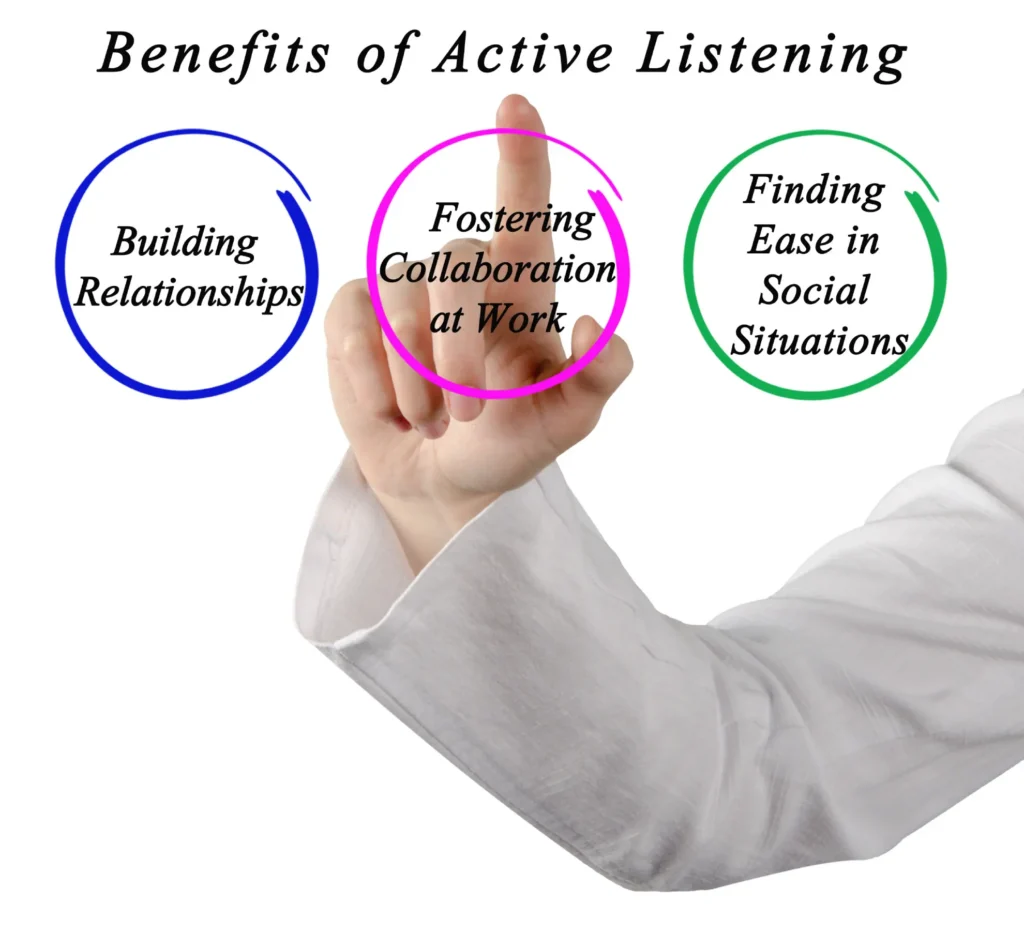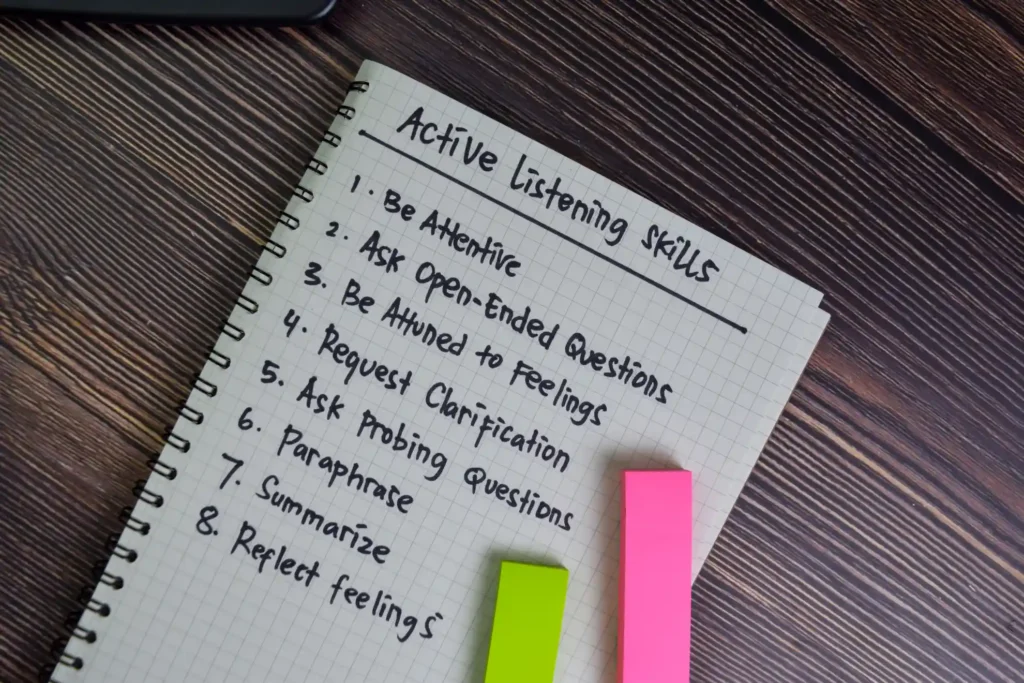Listening in communication is an essential skill in all areas of life, whether you’re supporting a loved one, dealing with colleagues, or in family relationships. But most of us aren’t as good at listening as we’d like to think. Active listening can help avoid miscommunication and reduce the potential for conflict. When we show we’re really listening, it’s more rewarding for the person talking, and you’ll get more out of it, too.
Have you ever been in a conversation where the other person wasn’t listening? Maybe they were distracted, thinking about their response, or just uninterested. It’s frustrating and even discouraging. Active listening communication ensures that all parties are heard and understood. This skill requires focus, patience, and an open mind.
Active listening is the process of absorbing the information someone shares with you and reflecting back—through questions and body language—that you heard them. It is a valuable workplace skill that leads to more transparent executive communication and more effective relationships with colleagues, managers, and clients. Like any skill, you can improve active listening with practice and by approaching conversations with greater intention.
This article will explain active listening definition, its benefits, and techniques for communicating better and improving your active listening skills.
Key Takeaways
- Be Present in Conversations: Use eye contact, open body language, and facial expressions to show you’re listening. Avoid distractions like phones to focus entirely on the speaker.
- Listen Patiently Without Interrupting: Allow the speaker to finish their thoughts without jumping in. This fosters better understanding and shows respect for their message.
- Avoid Judgment: Listen with an open mind and withhold personal opinions. This creates a safe environment for honest and open communication.
- Ask Open Questions: Encourage deeper discussions with questions beyond a yes or no answer. This shows genuine interest and helps uncover detailed insights.
Defining Active Listening
Active listening is a practice that helps people understand each other better and communicate more effectively. It means paying full attention to the speaker and genuinely understanding their message. This involves more than just attentive listening; it requires engagement and careful attention to detail.
When we actively listen, we show respect to the speaker and create a space for open and honest communication. This approach helps us connect on a deeper level, building stronger relationships and improving communication skills. Active listening also helps us see different perspectives, avoid communication gaps, and solve problems more effectively.
Active listening involves being sensitive to the speaker’s needs and underlying messages and providing feedback without judging or interrupting our agenda. It’s a crucial skill that can be challenging, even for experienced speakers.
Many times, we don’t remember much of what we hear. Studies show that the average person only recalls 25% of a talk or lecture after two months. Active listening, which involves deeper attention and empathy, can lead to better understanding and retention. Carl Rogers first developed this method for psychologists in the 1950s, and it is also known as “reflective listening.” Today, it is used in various fields like business and education.
By practicing active listening, we remember essential information and make the speaker feel understood. It’s about being a mindful and focused participant in the conversation, attuning to both the speaker’s words and their underlying thoughts and feelings. This turns conversations into active, cooperative interactions rather than competitive exchanges.
What are the Benefits of Active Listening?

Active listening comprises supportive listening behaviors that can transform your workplace experience and improve your career. Here are some of the benefits:
Enhances Teamwork and Collaboration
Active listening is essential for effective teamwork. By listening carefully, you can understand your colleagues better, avoid misunderstandings, and make better decisions. It also helps build genuine connections by showing respect and valuing others’ opinions, fostering a positive and collaborative work environment.
Builds Trust
Trust is crucial in any professional relationship. You build trust and credibility by showing genuine interest in what others say and engaging with their ideas. Techniques like paraphrasing and using verbal cues show that you are actively engaged and committed to understanding their perspective. This creates a sense of rapport and strengthens relationships.
Improves Problem-Solving
Active listening helps identify and solve problems effectively. You can find better solutions by understanding the underlying issues through careful listening. This open communication fosters an environment where problems can be discussed honestly, leading to successful resolutions.
Expands Knowledge
Active listening allows you to assimilate information more effectively, enhancing your understanding of various topics. Focusing on the main points and asking for clarification when needed ensures you don’t miss crucial details. This broadens your knowledge and improves comprehension in different areas.
Boosts Emotional Intelligence
One component of active listening is empathic communication that helps you manage your emotions and understand others better. It makes people feel heard and valued, essential for building meaningful relationships. Empathy and good interpersonal skills are strong predictors of workplace success.
Reduces Conflict
By improving your listening skills, you can avoid conflicts and misunderstandings. This enhances your productivity and ability to influence, persuade, and negotiate. Effective listening is necessary for maintaining a harmonious work environment.
Enhances Leadership Skills
The importance of active listening cannot be understated for those in supervisory roles. It helps you understand issues and collaborate on solutions, showcasing your patience and leadership abilities. It also contributes to workplace safety in fields like healthcare by reducing errors and preventing harm.
Promotes Psychological Safety
Active listening fosters a sense of belonging and psychological safety at work. It shows that you value others’ input, encouraging them to share their perspectives. This inclusivity enhances team effectiveness and overall workplace success.
Incorporating active listening into your daily interactive communication will improve your professional and personal relationships noticeably, making you a more effective leader and collaborator.
Active Listening Techniques to Communicate Better

Be Present
Active listening is essential for effective communication. Here are some active listening steps to help you be present during conversations.
Eye Contact and Body Language
Maintaining eye contact shows you’re listening, but too much can be intimidating. Try the 50/70 rule: keep eye contact 50% to 70% of the time, holding it for four to five seconds before briefly looking away. This keeps the conversation comfortable. Pair this with open body language—avoid crossing your arms or legs. Lean forward slightly or tilt your head to show interest.
Facial Expressions and Gestures
Your facial expressions and gestures speak volumes. Smile, nod, and use facial cues to show you’re engaged. Pay attention to the speaker’s expressions and body language, too. Acknowledge their feelings with your expressions and gestures if they seem tired or upset.
Avoid Distractions
In our fast-paced world, getting distracted by phones and notifications is easy. Put away your phone and ignore other distractions. Focus entirely on the speaker. This shows respect and ensures you don’t miss important details.
Mindfulness
Being present means being mindful. Listen without daydreaming or planning your response. Take in what the speaker is saying with full attention. This builds a genuine connection and helps you understand their message better.
Non-Verbal Cues
Communication is largely nonverbal. Smiling and maintaining an open posture can show you’re listening. Notice the speaker’s nonverbal signals, too. These can reveal more about their feelings and intentions.
Engagement and Encouragement
Use small verbal comments like “yes” and “uh-huh” to encourage the person speaking. Allow pauses in the conversation for them to gather their thoughts. Avoid interrupting or finishing their sentences. This sets a comfortable tone and shows you value their input.
By practicing these techniques, you’ll become a better listener and communicator. Being fully present in your conversations helps build stronger, more meaningful connections.
Listen Patiently without Interruption
Listening patiently is critical to effective communication. Interrupting someone can be frustrating for them, making it seem like you think you’re more important or too busy to listen. If you tend to think or speak quickly, slow down and give the other person time to express themselves. A few seconds of silence doesn’t mean you need to jump in.
Letting others speak without interrupting makes it easier to understand their message. Even well-meaning interruptions can sidetrack the conversation. If that happens, gently steer it back by saying, “So, you were telling me about…”
Being patient while listening means giving the speaker enough time to articulate their thoughts fully. Resist the urge to interrupt or rush them. This helps you better understand their message and intentions. Allowing pauses and moments of silence gives the speaker time to gather their thoughts, fostering a supportive environment for open and honest communication.
Often, we listen with our agenda in mind, ready to interject before the other person has finished speaking. This shows that we care more about what we have to say. Next time you’re conversing, hold back your thoughts and truly hear the other person out. Seek to understand their point of view and the message behind their words before responding.
Patience in listening means not filling silence with your thoughts or stories. Listen to understand, not to respond. Avoid preparing a reply while the other person is still talking, and don’t abruptly change the subject. Act as a sounding board during active listening rather than jumping in with your ideas and opinions.
Do Not Judge
When practicing active listening, it is crucial not to judge the speaker. Reacting emotionally to what’s being said can hinder your ability to listen to what comes next. Focus on listening without making assumptions about what will be said next.
Creating an open, non-threatening atmosphere is vital. Withholding judgment means suspending your personal opinions and biases. This helps you to understand the speaker’s perspective objectively. When people feel they won’t be judged, they communicate more honestly. This practice can lead to stronger connections, deeper insights, and meaningful relationships.
Avoid passing judgment when responding. Your body language or words can unintentionally come across as critical. For example, asking “Why?” questions or raising your eyebrows can make the speaker feel criticized and unsupported. Instead, remain open, neutral, and nonjudgmental.
Interrupting is counterproductive. It frustrates the speaker and prevents a complete understanding of their message. Let the speaker finish before asking questions and avoid interrupting with counterarguments.
Staying neutral and nonjudgmental helps create a safe zone for sharing thoughts. It builds trust, showing the speaker they won’t be shamed or criticized. Being less judgmental includes expressing empathy, learning about different cultures, practicing acceptance, and recognizing when you might be judging.
Active listening requires us to be open to new ideas and perspectives. Even with strong views, good listeners suspend judgment, hold criticisms, and avoid interruptions. Maintaining an open body posture, such as keeping arms at your side rather than crossed, can also signal openness.
By withholding judgment and practicing active listening, you can engage with new ideas and perspectives, fostering better communication and understanding.
Leverage Open-ended Questions
Asking open-ended questions is a vital part of active listening. These questions help foster meaningful dialogue and show that you are genuinely interested in what the speaker has to say.
Open questions encourage the speaker to elaborate, which can lead to a more engaging and comfortable conversation. They require more than a “yes” or “no” response, prompting the speaker to share additional information and clarify their thoughts. This helps uncover deeper insights and promotes a better understanding of the topic.
As an example of active listening and questioning, instead of asking, “Did you like the meeting?” you could ask, “What did you think about the meeting?” This invites the speaker to provide a more detailed response. Other active listening examples include, “How did that make you feel?” or “What do you think is the best path forward?”
Using open questions also shows that you’ve been listening and are interested in learning more. It demonstrates curiosity and a willingness to explore the speaker’s perspective, which can help build a stronger connection between you and the speaker. By asking questions like, “Can you tell me more about that?” or “What new features would you like added to this product?” you encourage the speaker to dig deeper into their thoughts and feelings.
Asking open-ended questions is a valuable technique for active listening. It promotes detailed and thoughtful responses, helps clarify information, and shows that you are genuinely engaged in the conversation.
Paraphrase, Clarify, and Summarize
Active listening is about understanding and engaging with what others are saying. Here are some techniques to improve communication:
Reflect What You’ve Heard: Sometimes called reflecting, this means repeating what the other person said to show you understand. Reflective listening examples include “…sounds like you are saying…” This helps ensure you’ve got it right and allows for necessary corrections.
Paraphrase for Understanding: Reflecting on what you’ve heard demonstrates you’re paying attention and understand. Try putting what they said into your own words. This not only helps you understand but shows you’re actively engaged.
Match Their Tone: If they’re excited, match their enthusiasm; if they’re sad, acknowledge that too. Matching emotions helps connect better.
Confirm Understanding: Periodically repeat what you’ve understood and ask for confirmation, especially in important discussions. This reduces misunderstandings and keeps everyone on the same page.
Clarify and Summarize: Don’t hesitate to ask if something is unclear. Paraphrasing back what you understood helps fill in any gaps, and repeating key points ensures everyone is clear.
Restate Key Themes: Reiterate critical points as the conversation continues to confirm understanding and mutual responsibilities.
End on a Positive Note: Repeat the salient takeaways toward the end of the conversation. Sharing your thoughts shows you’ve understood and can lead to deeper discussions.
Using these techniques improves understanding and strengthens relationships through active listening.
Tips to Improve Your Active Listening Skills

Enhancing your active listening abilities can significantly enrich your communication experiences, whether it’s during meetings, casual chats, or even first encounters. You can become more engaged and attentive by being mindful of your listening habits and actively seeking improvement.
Engage in Active Listening Exercises
Participate in exercises and role-playing activities designed to bolster your active listening skills. These resources, available in communication workshops or online platforms, provide practical methods to enhance your listening prowess.
Continually Learn and Practice
Expand your knowledge by reading books or enrolling in courses centered around communication skills. Engage in practice conversations and actively seek feedback to refine your listening techniques. Remember, the more you learn and practice, the more adept you become at active listening.
Foster Curiosity
Encourage your innate curiosity to deepen your engagement in conversations. When genuinely curious about a topic, you naturally ask more questions and strive to understand better, laying a solid foundation for active listening.
Find Common Ground
Discover shared interests with your conversation partner, making staying fully engaged during discussions easier. Identifying mutual passions facilitates a more meaningful exchange, fostering a conducive environment for active listening.
Know When to Conclude Conversations
Recognize when it’s appropriate to gracefully exit a conversation, especially if the other person shows disinterest. Ending a dialogue respectfully can prevent frustration and ensure both parties feel heard and respected.
Seek Professional Support if Needed
If you encounter persistent difficulties with active listening, consider seeking professional assistance or engaging in social skills training. Self-help books focusing on interpersonal skills can also provide valuable insights and strategies for improvement.
Incorporating these easy yet effective active listening tips into your daily interactions can sharpen your active listening skills and nurture more profound connections with those around you. Remember, active listening is a skill that evolves with practice and dedication.
Boost Your Communication with Active Listening
Active listening is crucial for building stronger relationships and effective communication in all areas of life. You can transform your interactions by genuinely focusing on the speaker, understanding their message, and responding thoughtfully. This practice goes beyond just hearing words; the components of active listening involve engaging with the speaker’s emotions and underlying messages.
To be an active listener, start by being fully present in conversations. Maintain eye contact and confident body language to reflect your engagement. Listen patiently without interrupting, allowing the speaker to express their thoughts fully. Avoid passing judgment and keep an open mind to foster a safe space for honest business communication. Asking open questions encourages deeper discussion and demonstrates your genuine interest. Additionally, paraphrasing the speaker’s points ensures clarity and mutual understanding.
By incorporating these active listening strategies, you will improve your comprehension and retention and build trust and rapport. Active listening enhances teamwork, reduces conflicts, and boosts emotional intelligence, making it a valuable skill in personal and professional settings. Practice active listening regularly to become a more empathetic and effective communicator.
Frequently Asked Questions
1. What is active listening and why is it important?
Active listening means entirely focusing on the speaker and genuinely understanding their message. It involves engaging with the speaker’s words and emotions, showing that you are genuinely interested in what they say.
2. What are active listening skills and how can I master them?
Active listening includes maintaining eye contact, avoiding distractions, and using open body language. Practice listening patiently without interrupting, asking open questions, and summarizing the speaker’s words to master active listening.
3. Why is active listening important in the workplace?
Active listening enhances teamwork and collaboration, builds trust, improves problem-solving, and boosts emotional intelligence. It also helps reduce conflicts and promotes a positive work environment.
4. Why is it important not to judge when listening?
Not judging the speaker creates a safe space for open and honest communication. It allows you to understand their perspective without bias, fostering stronger connections and deeper insights.
Master Active Listening with Prezentium: Transform Your Communication Skills
Unlock the full potential of your communication with Prezentium’s innovative services. These services are designed to help you master active listening and create powerful presentations. Whether you need a top-tier overnight presentation, professional design assistance, or engaging communication training, Prezentium is your go-to partner.
Imagine sending your presentation requirements by 5:30 pm PST and receiving a meticulously crafted, data-driven presentation by 9:30 am PST the next business day. Our Overnight Presentations service combines business acumen, visual design, and data science to ensure your message is heard and understood.
For those seeking to elevate their ideas into visually stunning presentations, our Prezentation Specialist team transforms meeting notes and rough drafts into polished masterpieces. With their expertise, you can focus on delivering your message while we handle the design intricacies.
To foster active listening and enhance your communication skills, enroll in Zenith Learning workshops. These interactive sessions are designed to improve structured problem-solving and visual storytelling, equipping you with the tools to listen actively and respond effectively in any conversation.
Enhance your communication, build stronger relationships, and ensure your message resonates with your target audience. Partner with Prezentium today and experience the transformative power of active listening in your professional interactions. Contact us now to get started!
